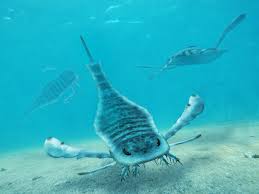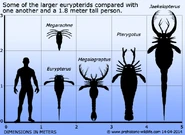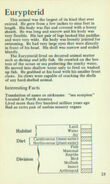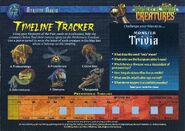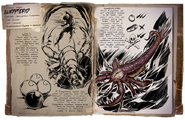Eurypterids (sea scorpions) are an extinct group of arthropods related to arachnids which include some of the largest known arthropods that ever lived. They are members of the extinct order Eurypterida (Chelicerata); which is the most diverse Paleozoic chelicerate order in terms of species.
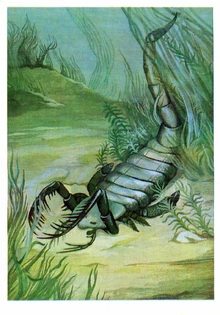
The name Eurypterida comes from the Greek word eury- meaning "broad" or "wide" and the Greek word pteron meaning "wing", for the pair of wide swimming appendages on the first fossil eurypterids discovered. Eurypterids predate the earliest fishes. The largest, such as Jaekelopterus, reached 2.5 metres (8 ft 2 in) or more in length, but most species were less than 20 centimetres (8 in). They were formidable predators that thrived in warm shallow water, in both seas and lakes,[3] in the Ordovician to Permian from 460 to 248 million years ago. Although informally called "sea scorpions", only the earliest ones were marine (later ones lived in brackish or freshwater), and they were not true scorpions. According to theory, the move from the sea to fresh water probably occurred by the Pennsylvanian subperiod. Eurypterids are believed to have undergone ecdysis, making their significance in ecosystems difficult to assess, because it can be difficult to tell a fossil moult from a true fossil carcass.[4] They went extinct during the Permian–Triassic extinction event 252.2 million years ago, and their fossils have a near global distribution. About two dozen families of eurypterids are known. Perhaps the best-known genus of eurypterid is Eurypterus, of which around 16 fossil species are known. The genus Eurypterus was described in 1825 by James Ellsworth De Kay, a zoologist. He recognized the arthropod nature of the first ever described eurypterid specimen, found by Dr. S. L. Mitchill. In 1984, that species, Eurypterus remipes was named the State fossil of New York.
List of families and genera[]
There are 246 valid species of eurypterids as of 2011. All of them are extinct. They are grouped into the following:
- Suborder Stylonurina Diener, 1924
- Superfamily Rhenopteroidea Størmer, 1951
- Rhenopteridae Størmer, 1951
-
- Alkenopterus Størmer, 1974
- Brachyopterella Kjellesvig-Waering, 1966
- Brachyopterus Størmer, 1951
- Kiaeropterus Waterston, 1979
- Leiopterella Lamsdell, Braddy, Loeffler, & Dineley, 2010
- Rhenopterus Størmer, 1936
- Superfamily Stylonuroidea Kjellesvig-Waering, 1959
- Parastylonuridae Waterston, 1979
- Parastylonurus Kjellesvig-Waering, 1966
- Stylonurella Kjellesvig-Waering, 1966
- Stylonuridae Diener, 1924
- Ctenopterus Clarke & Ruedemann, 1912
- Laurieipterus Kjellesvig-Waering, 1966
- Pagea Waterston, 1962
- Stylonurus Page, 1856
- Superfamily Kokomopteroidea Kjellesvig-Waering, 1966
- Kokomopteridae Kjellesvig-Waering, 1966
- Kokomopterus Kjellesvig-Waering, 1966
- Lamontopterus Waterston, 1979
- Hardieopteridae Tollerton, 1989
- Hallipterus Kjellesvig-Waering, 1963
- Tarsopterella Størmer, 1951
- Superfamily Hibbertopteroidea Kjellesvig-Waering, 1959
- Drepanopteridae Kjellesvig-Waering, 1966
- Drepanopterus Laurie, 1892
- Hibbertopteridae Kjellesvig-Waering, 1959
- Campylocephalus Eichwald, 1860
- Cyrtoctenus Størmer & Waterston, 1968
- Dunsopterus Waterston, 1968
- Hastimima White, 1908
- Hibbertopterus Kjellesvig-Waering, 1959
- Vernonopterus Waterston, 1957
- Mycteroptidae Cope, 1886
- Megarachne Hünicken, 1980
- Mycterops Cope, 1886
- Woodwardopterus Kjellesvig-Waering, 1959
- Stylonuroides Kjellesvig-Waering, 1966
- Suborder Eurypterina Burmeister, 1843
- Plesion taxa
-
- Onychopterella Størmer, 1951
- Superfamily Moselopteroidea Lamsdell, Braddy, & Tetlie, 2010
- Moselopteridae Lamsdell, Braddy, & Tetlie, 2010
- Moselopterus Størmer, 1974
- Vinetopterus Poschmann & Tetlie, 2004
- Superfamily Megalograptoidea Caster & Kjellesvig-Waering, 1955
- Megalograptidae Caster & Kjellesvig-Waering, 1955
- Echinognathus Walcott, 1882
- Megalograptus Miller, 1874
- Superfamily Eurypteroidea Burmeister, 1843
- Dolichopteridae Kjellesvig-Waering & Størmer, 1952
- Dolichopterus Hall, 1859
- Ruedemannipterus Kjellesvig-Waering, 1966
- Buffalopterus Kjellesvig-Waering & Heubusch, 1962
- Strobilopterus Ruedemann, 1935
- Syntomopterus Kjellesvig-Waering, 1961
- Eurypteridae Burmeister, 1843
- Eurypterus De Kay, 1825
- Erieopteridae Tollerton, 1989
- Erieopterus Kjellesvig-Waering, 1958
- Superfamily Mixopteroidea Caster & Kjellesvig-Waering, 1955
- Carcinosomatidae Størmer, 1934
- Carcinosoma Claypole, 1890
- Eocarcinosoma Caster & Kjellesvig-Waering, 1964
- Paracarcinosoma Caster & Kjellesvig-Waering, 1964
- Rhinocarcinosoma Novojilov, 1962
- Micopteridae Caster & Kjellesvig-Waering, 1955
- Lanarkopterus Ritchie, 1968
- Mixopterus Ruedemann, 1921
- Superfamily Waeringopteroidea
- Waeringopteridae (not formally published)
- Grossopterus Størmer, 1934
- Orcanopterus Stott, Tetlie, Braddy, Nowlan, Glasser, & Devereux, 2005
- Waeringopterus Leutze, 1961
- Superfamily Adelophthalmoidea Tollerton, 1989
- Adelophthalmidae Tollerton, 1989
- Adelophthalmus Jordan in Jordan & von Mayer, 1854
- Bassipterus Kjellesvig-Waering & Leutze, 1966
- Eysyslopterus Tetlie & Poschmann, 2008
- Nanahughmilleria Kjellesvig-Waering, 1961
- Parahughmilleria Kjellesvig-Waering, 1961
- Pittsfordipterus Kjellesvig-Waering & Leutze, 1966
- Superfamily Pterygotioidea Clarke & Ruedemann, 1912
- Hughmilleriidae Kjellesvig-Waering, 1951
- Herefordopterus Tetlie, 2006
- Hughmilleria Sarle, 1902
- Slimonidae Novojilov, 1968
- Slimonia Page, 1856
- Salteropterus Kjellesvig-Waering, 1951
- Pterygotidae Clarke & Ruedemann, 1912
- Pterygotus Agassiz, 1839
- Acutiramus Ruedemann, 1935
- Ciurcopterus Tetlie & Briggs, 2009
- Erettopterus Salter in Huxley & Salter, 1859
- Jaekelopterus Waterston, 1964
- Clarkiepterus Kjellesvig-Waering, 1966
- Dorfopterus Kjellesvig-Waering, 1955
- Holmipterus Kjellesvig-Waering, 1979
- Marsupipterus Caster & Kjellesvig-Waering, 1955
- Tylopterella Størmer, 1951
- Unionopterus Chernyshev, 1948
The trace fossil trackways produced by eurypterids are placed in the ichnogenus Palmichnium.
